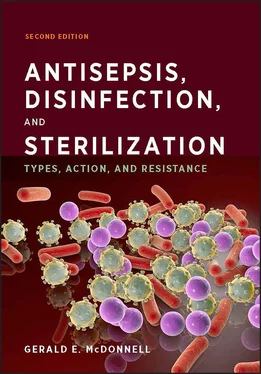..TABLE 8.14 Ranges of MICs and MBCs of chlorhexidine and triclosan against S. aur...TABLE 8.15 MICs of various biocides (determined in test media) for gram-positive...TABLE 8.16 Possible transport mechanisms of some biocides into gram-negative bac...TABLE 8.17 Acquired mechanisms of resistance to antimicrobial drugsTABLE 8.18 Examples of RND efflux pumps associated with biocide resistance in P....TABLE 8.19 Examples of mutations causing increased sensitivity to biocidesTABLE 8.20 Identified and possible mechanisms of plasmid-encoded resistance to b...TABLE 8.21 Examples of acquired (plasmid or transposon) resistance to mercury in...TABLE 8.22 Examples of plasmid-mediated resistance to silver and copper in bacte...TABLE 8.23 Plasmid-mediated resistance to various toxic metals in bacteriaTABLE 8.24 Examples of qac genes and susceptibilities of S. aureus strains to bi...TABLE 8.25 qac genes and resistance to QACs and other biocidesTABLE 8.26 Viral classification and response to biocidesaTABLE 8.27 Effects of various disinfection and sterilization methods on prionsTABLE 8.28 Possible mechanisms of fungal resistance to biocidesTABLE 8.29 Comparison of the relative resistances of bacteria and fungi to bioci...TABLE 8.30 Fungicidal concentrations of biocides for yeasts and moldsTABLE 8.31 Various cell wall structures of fungiTABLE 8.32 Parameters affecting the response of S. cerevisiae to chlorhexidineTABLE 8.33 Examples of spores produced by fungiTABLE 8.34 Minimum amoebicidal concentrations for Acanthamoeba trophozoites and ...
1 Chapter 1 FIGURE 1.1 A typical helminth life cycle (example: Enterobius vermicularis). FIGURE 1.2 Typical fungal structures. (A) Filamentous fungus (mold). Hyphae are ... FIGURE 1.3 Simplified fungal cell envelope. The cross-linked cell wall is linked... FIGURE 1.4 Life cycle of Toxoplasma gondii. FIGURE 1.5 Simple representation of a mycoplasma cell surface structure. FIGURE 1.6 Basic structure of a bacterial cell, showing the cell surface in grea... FIGURE 1.7 Bacterial cell wall structures. The cell membranes are similar struct... FIGURE 1.8 Basic structure of peptidoglycan. Polysaccharides of repeating sugars... FIGURE 1.9 Cells of Mycobacterium tuberculosis. Courtesy of Clifton Barry, NIAID... FIGURE 1.10 Basic viral structure. FIGURE 1.11 Typical viral life cycle. The stages include (1) attachment, (2) pen... FIGURE 1.12 E. coli bacteriophages. The T-phages are complex DNA viruses; MS2 an... FIGURE 1.13 Theory of prions as infectious proteins. PrPc is the normal form of ... FIGURE 1.14 Representation of the proposed structural changes in PrP. FIGURE 1.15 The general structure of lipopolysaccharide. The lipid A component i... FIGURE 1.16 Typical fungal aflatoxin structure. FIGURE 1.17 General microbial resistance to biocides and biocidal processes. Thi... FIGURE 1.18 Typical time kill, or D-value, determination. A known concentration ... FIGURE 1.19 Determination of the D value on microbial exposure to a biocide. FIGURE 1.20 Typical survivor curves on biocide exposure. Curve 1 is concave down... FIGURE 1.21 Qualitative and semiquantitative population determinations. FIGURE 1.22 D-value estimation using most probable number estimations. FIGURE 1.23 Example of a self-contained biological indicator. The 3M Attest 1292... FIGURE 1.24 Example of a chemical-indicator color change. FIGURE 1.25 Rate of microbial inactivation on exposure to sterilization processe... FIGURE 1.26 Basic structures of surfactants and soaps and micelles (a water-in-o... FIGURE 1.27 Examples of single (left)- and multiple (right)-chamber washer and w... FIGURE 1.28 Various types of cleaning chemical formulations.
2 Chapter 2 FIGURE 2.1 Typical microbial sensitivities to moist-heat disinfection. FIGURE 2.2 Effect of temperature on microbial lethality and Z-value determinatio... FIGURE 2.3 A pasteurizer for heat treatment of liquids. Courtesy of System Produ... FIGURE 2.4 Moist-heat resistance of microorganisms. FIGURE 2.5 Atomic structure and the source of radiation. FIGURE 2.6 The electromagnetic spectrum. The range of wavelengths is shown on th... FIGURE 2.7 A representation of a typical UV (low-pressure UV mercury) lamp and t...FIGURE 2.8 Simple structure of a magnetron used for the production of microwaves...FIGURE 2.9 A simple continuous-duty UV disinfection system for liquids. The UV l...FIGURE 2.10 The theory of filtration. Various types of filtration processes are ...FIGURE 2.11 The microscopic structures of the surfaces of three filter materials...FIGURE 2.12 Examples of a variety of liquid filter types. Reproduced with permis...FIGURE 2.13 An example of a rigid-walled isolator system, with glove access port...FIGURE 2.14 Air pressure in environmentally controlled enclosed areas. (A) Rooms...FIGURE 2.15 Biological safety class I, II, and III cabinets. Class I cabinets pr...FIGURE 2.16 Range of filtration methods and reference size exclusion capabilitie...
3 Chapter 3FIGURE 3.1 Dissociation of benzoic acid. As the pH increases, the dissociation o...FIGURE 3.2 High-level disinfectants for medical-device disinfection based on 2.4...FIGURE 3.3 Examples of formaldehyde-releasing agents.FIGURE 3.4 Examples of an alcohol-based disinfectant (left) and an alcohol-based...FIGURE 3.5 Aminoacridines commonly used as antiseptics.FIGURE 3.6 Examples of chlorhexidine-based antiseptics and disinfectants. Courte...FIGURE 3.7 An example of an essential-oilcontaining disinfectant.FIGURE 3.8 Simplified chemistry of iodine in water, demonstrating those species ...FIGURE 3.9 The structure of PVPI. The polymer consists of repeating units of the...FIGURE 3.10 Various types of PVPI antiseptic products. Reproduced with permissio...FIGURE 3.11 Simplified chemistry of chlorine in water, demonstrating those speci...FIGURE 3.12 Examples of organic chloramines.FIGURE 3.13 Typical bromine-releasing agents. PSHB is an example of a water-inso...FIGURE 3.14 Sodium hypochlorite (bleach)-based disinfectant. A concentrate (whic...FIGURE 3.15 Silver sulfadiazine.FIGURE 3.16 A typical copper-silver ionization system. The electrode cell consis...FIGURE 3.17 Structure of benzoyl peroxide.FIGURE 3.18 Example of the generation of PAA from sodium perborate and acetylsal...FIGURE 3.19 Examples of the production of chlorine dioxide from chlorine.FIGURE 3.20 Examples of ozone generators. Courtesy of Absolute Systems (left) an...FIGURE 3.21 Examples of vaporized hydrogen peroxide (VHP) generators. The exampl...FIGURE 3.22 Typical room fumigation setup with a hydrogen peroxide gas generator...FIGURE 3.23 A range of chlorine dioxide-based liquid formulations for medical-de...FIGURE 3.24 A chlorine dioxide gas generator for liquid applications. Courtesy o...FIGURE 3.25 A typical chlorine dioxide fumigation cycle. The biocide concentrati...FIGURE 3.26 The effect of temperature on the sporicidal efficacy of PAA. The ave...FIGURE 3.27 Phenolic-based disinfectants. Both are formulation concentrates (whi...FIGURE 3.28 Typical bisphenolic structures.FIGURE 3.29 The modes of action of triclosan and hexachloro phene against enoyl ...FIGURE 3.30 Basic surfactant and micelle structures.FIGURE 3.31 The basic structure of QACs.FIGURE 3.32 QAC-based disinfectants. A readyto-use spray formulation and an exam...FIGURE 3.33 Examples of chlorine-based N-halamines.FIGURE 3.34 The enzymatic activity of lysozyme. The structure of peptidoglycan (...
4 Chapter 4FIGURE 4.1 Cross section of skin structure. Illustration by Patrick Lane, ScEYEn...FIGURE 4.2 Examples of various types of antiseptic products.FIGURE 4.3 Examples of biocide-impregnated materials for skin application.FIGURE 4.4 A representation of the penetration of chlorhexidine into the skin ep...
5 Chapter 5FIGURE 5.1 The relationship between saturated steam temperature and pressure.FIGURE 5.2 A steam sterilizer. Sterilizers are available in a variety of sizes a...FIGURE 5.3 The basic design of an upward-displacement steam sterilizer.FIGURE 5.4 The basic design of a downward-displacement steam sterilizer.FIGURE 5.5 The basic design of a prevacuum steam sterilizer.FIGURE 5.6 Typical steam sterilization cycles, showing different mechanisms of a...FIGURE 5.7 The Bowie-Dick test, a method of testing the steam penetration and ai...FIGURE 5.8 Typical water pretreatment systems for the production of steam.FIGURE 5.9 Effect of temperature on the lethality of a G. stearothermophilus spo...FIGURE 5.10 An industrial dry-heat sterilizer, which is used for depyrogenation....FIGURE 5.11 Representative effects of humidity/water content on the dry-heat res...FIGURE 5.12 Generation and decay of 60Co.FIGURE 5.13 The generation of X rays. Electrons are shown being generated from t...FIGURE 5.14 A simplified linear high-energy E-beam generator.FIGURE 5.15 A typical γ-irradiator sterilizer.FIGURE 5.16 A typical exposure rack containing 60Co as a γ-radiation source with...FIGURE 5.17 A typical E-beam sterilizer. An X-ray sterilizer may be in a similar...FIGURE 5.18 Example of plasma generation with oxygen gas (O2).FIGURE 5.19 An example of a pulsed-light sterilizer. Courtesy of Xenon Corporati...FIGURE 5.20 The relationship between solid, liquid, gas, and supercritical fluid...
Читать дальше












